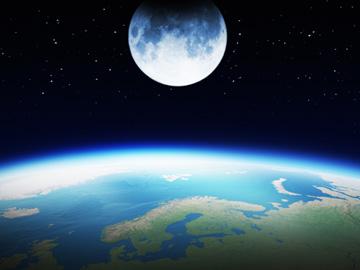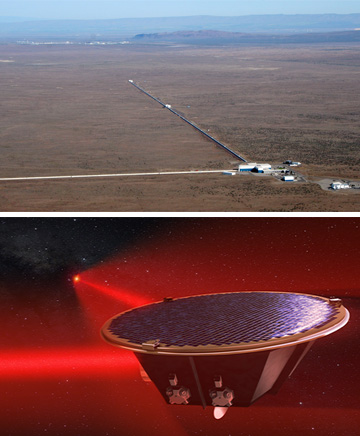
[Image: Getty Images]
A large hole in the observable gravitational-wave spectrum could in part be filled by exploiting laser ranging to make extremely precise measurements of variations in the moon’s orbit. That is the conclusion of two scientists in Europe, who have calculated that interactions with binary systems could reveal currently undetectable primordial gravitational radiation at microhertz frequencies (Phys. Rev. Lett., doi: 10.1103/PhysRevLett.128.101103).
Filling the frequency gap
Gravitational waves are minute oscillations in the fabric of space-time first observed directly in 2015 by the Laser Interferometer Gravitational-wave Observatory (LIGO), a pair of giant facilities in the United States. LIGO and the Virgo observatory in Italy have since racked up dozens of detections of gravitational waves from black holes and neutron stars, while turning-on in 2020 of KAGRA, a similar observatory in Japan, is expected to accelerate new sightings.
Such facilities, though, can observe only a fairly limited portion of the gravitational-wave spectrum—around 10 Hz to 1 kHz. Scientists hope to start taking data from the Laser Interferometer Space Antenna (LISA) mission, a project of the European Space Agency, in around the mid-2030s. LISA will fire laser beams between three spacecraft spaced a million kilometers apart in a triangular formation to detect the millihertz frequency range. With pulsar timing arrays operating at nanohertz frequencies, that leaves a gap between about 10−7 and 10−4 Hz.
A mathematical approach
In the latest work, Diego Blas at the Autonomous University of Barcelona in Spain and Alexander Jenkins at University College London in the United Kingdom show how at least some of this shortfall could be met by measuring tiny variations in the separation of a pair of orbiting celestial bodies brought about by a passing gravitational wave. If the gravitational-wave frequency is an integer multiple of the orbital frequency, the researchers point out, resonance causes the orbital perturbation to build up over time and register a larger signal than it otherwise would.
The researchers explain that these binary systems are best suited to measure what is known as the stochastic gravitational-wave background, which consists of the incoherent superposition of radiation emitted by a broad range of sources throughout the history of the universe. Being continuous and broadband, this background can be picked up through binary measurements even if those target relatively small numbers of discrete frequencies.
Blas and Jenkins have developed a mathematical formalism that allows them to keep track of deviations from a Keplerian elliptical orbit in six different parameters, including the orbital period, eccentricity and inclination. Because the jumble of waves that make up the stochastic background results in a random wave form, the formalism cannot be used to predict exactly how these parameters will evolve for any given binary system. Instead, it sets up a probability distribution for each parameter and yields the variation in those distributions over time.

New work suggests that laser ranging of the Earth–moon system could help fill a frequency gap in gravitational-wave data not covered by observatories such as the Earth-based LIGO (top) and the future space-based LISA observatory (bottom). [Image: LIGO Lab/Caltech/MIT (top); AEI/Milde Marketing/Exozet (bottom)]
Bouncing laser beams off satellites
The researchers calculated the kinds of sensitivities that could be achieved using this approach to analyze the data from laser-ranging measurements involving terrestrial satellites—both those carried out by bouncing beams off the moon (thanks to Apollo-era mirrors left on the surface) and those exploiting reflections from artificial satellites.
In the former case, they calculated that about 1,000 measurements carried out with the roughly 3-mm precision possible today should enable detection of gravitational waves inducing a strain of around one part in 1015 (compared to LIGO’s roughly 1 part in 1021) at a frequency of 0.85 μHz. For measurements involving the LAGEOS satellite, the researchers arrived at a sensitivity of around one part in 1017 at 0.15 mHz. In both cases, they considered the second harmonic—which, they say, yields by far the strongest coupling for nearly circular orbits such as these.
More specifically, the researchers established that both types of measurement ought to be able to pick out signals from so-called cosmological first-order phase transitions. These transitions of quantum fields to more energetically preferable states, thought to have occurred within the first fraction of a second of the universe’s existence, are predicted by many extensions to the standard model of particle physics and should generate a narrow spectrum with a peak frequency.
“Reasons to be optimistic”
Looking to the future, the researchers estimate how much these sensitivities might be increased via feasible improvements to laser-ranging systems’ noise levels and rate of data collection. They reckon that lunar ranging could get down to about 5 parts in 109 by the time that LISA completes its nominal four-year mission (scheduled for 2038), while satellite measurements could reach about 8 parts in 109 over the same period. They point out that the latter ought to be comfortably exceeded by LISA itself, but believe that data from LAGEOS could still provide valuable results in the meantime.
In addition, they say that measurements based on variations in the orbital periods of binary pulsars could also yield valuable information. Such measurements would not be as sensitive as those possible with laser ranging, but the range of binary-pulsar periods combined with the large eccentricities of many of the orbits involved means that the resulting data would cover a vast range of frequencies—from less than 10 nHz to about 0.1 mHz.
Having demonstrated the potential of binary resonance searches, Blas and Jenkins say the important thing now is that scientists analyzing data from laser-ranging and pulsar observations apply the newly developed formalism to their results. Such work, Blas and Jenkins say, could lead to the first discovery of stochastic background gravitational waves in this currently unexplored frequency range—or else set stringent upper limits on the intensity of such radiation.
“The history of both electromagnetic and gravitational-wave astronomy gives us plenty of reasons to be optimistic about the outcomes of these searches and their potential for scientific discovery,” they say.
